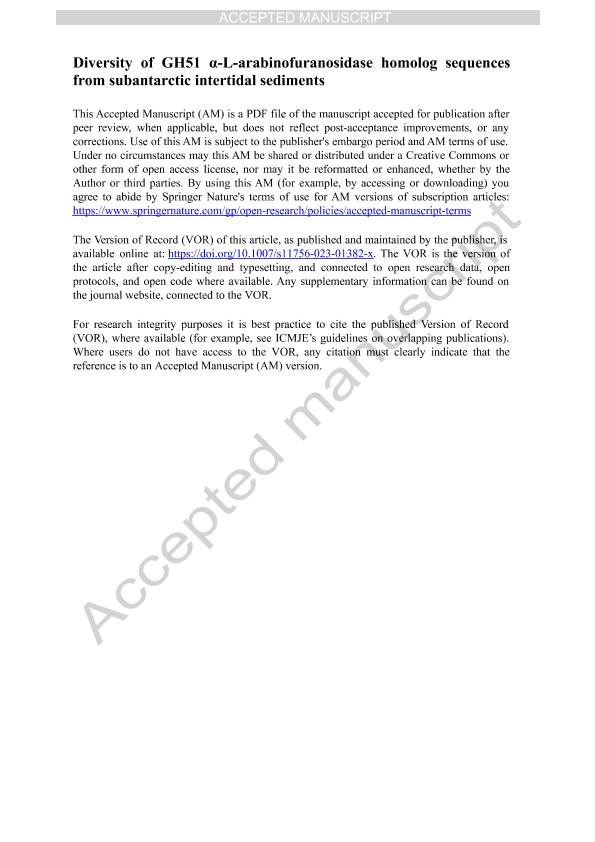Mostrar el registro sencillo del ítem
dc.contributor.author
Dionisi, Hebe Monica

dc.contributor.author
Lozada, Mariana

dc.contributor.author
Campos, Eleonora

dc.date.available
2024-02-28T11:56:21Z
dc.date.issued
2023-03
dc.identifier.citation
Dionisi, Hebe Monica; Lozada, Mariana; Campos, Eleonora; Diversity of GH51 α-L-arabinofuranosidase homolog sequences from subantarctic intertidal sediments; Versita; Biologia; 78; 7; 3-2023; 1899-1918
dc.identifier.issn
0006-3088
dc.identifier.uri
http://hdl.handle.net/11336/228706
dc.description.abstract
Bacteria from coastal habitats exposed to challenging environmental conditions constitute a promising source of enzymes with novel catalytic properties for the depolymerization of complex carbohydrates of terrestrial and marine origins. In this work, we investigated the sequence and structural diversity of putative enzymes related to the glycoside hydrolase family 51 (GH51) identified in a metagenomic dataset of intertidal sediments from a subantarctic environment. The majority of the characterized members of the GH51 family are α-L-arabinofuranosidases (EC 3.2.1.55), enzymes with important industrial applications that catalyze the hydrolysis of side chains from arabinose-substituted polysaccharides. The 28 sequences identified in the metagenome were highly diverse and were assigned to the Bacteroidota, Planctomycetota, Chloroflexota, Pseudomonadota, and Kiritimatiellaeota phyla, with four sequences remaining unassigned. In a sequence similarity network, most GH51 homolog sequences clustered with uncharacterized members of the GH51 family or were highly divergent. Three-dimensional models of the putative enzymes showed distinctive structural characteristics, including a highly variable length of the loop located between β-strand 2 and α-helix 2 and the absence in some of the sequences of a highly conserved Trp residue in this loop. Important differences in the predicted surface electrostatic potential in models of closely related GH51 homologs suggest various levels of adaptation to the prevailing environmental conditions. This work provides an insight into the characteristics of putative enzymes related to the GH51 family from intertidal sediment bacteria, from taxa that are relevant in the marine environment but remain poorly characterized due to the difficulties in their cultivation.
dc.format
application/pdf
dc.language.iso
eng
dc.publisher
Versita

dc.rights
info:eu-repo/semantics/openAccess
dc.rights.uri
https://creativecommons.org/licenses/by-nc-sa/2.5/ar/
dc.subject
GH51
dc.subject
GLYCOSIDE HYDROLASES
dc.subject
INTERTIDAL SEDIMENTS
dc.subject
METAGENOME
dc.subject
Α-L-ARABINOFURANOSIDASES
dc.subject.classification
Otras Biotecnología del Medio Ambiente

dc.subject.classification
Biotecnología del Medio Ambiente

dc.subject.classification
INGENIERÍAS Y TECNOLOGÍAS

dc.title
Diversity of GH51 α-L-arabinofuranosidase homolog sequences from subantarctic intertidal sediments
dc.type
info:eu-repo/semantics/article
dc.type
info:ar-repo/semantics/artículo
dc.type
info:eu-repo/semantics/publishedVersion
dc.date.updated
2024-02-28T10:34:57Z
dc.journal.volume
78
dc.journal.number
7
dc.journal.pagination
1899-1918
dc.journal.pais
Polonia

dc.description.fil
Fil: Dionisi, Hebe Monica. Consejo Nacional de Investigaciones Científicas y Técnicas. Centro Científico Tecnológico Conicet - Centro Nacional Patagónico. Centro para el Estudio de Sistemas Marinos; Argentina
dc.description.fil
Fil: Lozada, Mariana. Consejo Nacional de Investigaciones Científicas y Técnicas. Centro Científico Tecnológico Conicet - Centro Nacional Patagónico. Centro para el Estudio de Sistemas Marinos; Argentina
dc.description.fil
Fil: Campos, Eleonora. Instituto Nacional de Tecnología Agropecuaria. Centro de Investigación en Ciencias Veterinarias y Agronómicas. Instituto de Agrobiotecnología y Biología Molecular. Consejo Nacional de Investigaciones Científicas y Técnicas. Oficina de Coordinación Administrativa Parque Centenario. Instituto de Agrobiotecnología y Biología Molecular; Argentina
dc.journal.title
Biologia

dc.relation.alternativeid
info:eu-repo/semantics/altIdentifier/url/https://link.springer.com/collections/aeiicidbaf
dc.relation.alternativeid
info:eu-repo/semantics/altIdentifier/doi/http://dx.doi.org/10.1007/s11756-023-01382-x
Archivos asociados
